1 Context
Sustainable development can only succeed if all can participate. Therefore, to address global challenges and improve relationships with all stakeholders, reaching people through effective science communication is crucial [Jensen & Gerber, 2020]. At this interface between science and society, science communication can be complemented by sustainability communication. The latter’s purpose is to present a scientifically derived understanding of sustainable development challenges and effectively incorporate them into public discourse [Michelsen & Godemann, 2005]. However, sustainability issues are very complex and it is increasingly difficult to attract the public’s attention to socially relevant issues [Michelsen & Godemann, 2005].
Adolescents represent an important target group for sustainability communication, since they are heavily affected by environmental consequences, yet have the potential to enable positive change as they become more environmentally-conscious and are quick to engage in novel trends [Lee, 2011]. However, innovative content, attractive formats and narratives are needed to attract young audiences [Swiss Academies of Arts and Sciences, 2021].
1.1 The power of scientainment and games
According to the Swiss foundation Gebert Rüf [Gebert Rüf Stiftung, n.d.], Scientainment is a low-threshold way of communicating about education, research and innovation which intelligently combines entertainment with the imparting of knowledge. Scientainment projects combine «science» and «entertainment» with relevant topics, attractive formats and strong channels. Only when the personal connection to science is established, when the magic, the mysterious and the joy of discovery become tangible, can people be reached who have no direct or only an indirect connection to the education, research and innovation area.
Low-threshold communication that applies game-based and narrative approaches has been shown to increase a person’s awareness of sustainable development while keeping them engaged and entertained [Jaisli, Bättig-Frey, Eymann, Mariani & Stucki, 2019; Katsaliaki & Mustafee, 2015; Bättig-Frey, Jäger & Treichler Bratschi, 2018]. Games that are entertaining while also educational are called serious games [Katsaliaki & Mustafee, 2015; Mortara et al., 2014]. Through serious games, users are immersed in an active learning state. As a result, users are motivated to actively acquire knowledge instead of just passively receiving information [Mortara et al., 2014].
In recent years, escape games, as a specific genre of games, have experienced significant success. Often, players must search for clues and solve puzzles that are connected with a story in order to escape a room before the time runs out. This concept has also been successfully adopted by the education sector in so called educational escape games which motivate students to participate in game-based, collaborative learning sessions [Sanchez & Plumettaz-Sieber, 2019].
According to Cai [2013] outdoor experiences are especially important to raise awareness and appreciation of the environment and to motivate for environmentally friendly behavior.
Based on these latest findings, the Zombie mission was developed within a scientainment project to reach adolescents, sensitize for sustainability and to promote interest in science.
Hence, in this study, we analyze how such an approach serves as an innovative science or sustainability communication tool, respectively, and may engage young people.
2 Materials and methods
2.1 Place of action
The Zombie mission is set in the campus gardens of the University of Applied Sciences Zurich (ZHAW) in Wädenswil, Switzerland. The gardens, as depicted in Figure 1, serve as an infrastructure for research-based learning. The mission complements other innovative communication methods that help visitors to experience sustainability topics in a practical and sensory way. The gardens also serve as a public recreational area. As the gardens are open to schools and the public all year round, the Zombie mission can be played anytime.

2.2 Zombie mission app
The Zombie mission is a digital outdoor escape game designed for adolescents aged 12 and above. Since June 2019, the game has been available for download on smartphones for a fee, and it can be played in groups of two to four individuals within the campus gardens.
To make the Zombie mission an attractive game that adolescents would want to play in their free time, rather than an obvious awareness tool, it contains the following game elements: a thrilling storyline, 10 different puzzles with a reward system (points and moving along the story when correctly solving a puzzle) and competition with other players in form of a ranking board. In addition, Augmented Reality (AR) elements (e.g. short shooter sequence with zombies) and the race against the clock reinforce the Zombie mission as a recreational game.
A frame story was used as a motivational tool, to engage adolescents in the game by empathy, curiosity, motivation and immersion [Murmann & Avraamidou, 2014]. The story aims to assist players in immersing themselves into the fictional world, understanding real-world activities, such as interacting with exhibits in the gardens, and completing specific tasks or solving puzzles [Murmann & Avraamidou, 2014].
In an informal evaluation, the theme of zombies appealed to the target group. The frame story is fictional: the players are in search of clues from a researcher who had made a significant breakthrough in developing a vaccine against zombies but has disappeared after making a last desperate call for help. Figure 2 shows an example of a clue. The zombie theme was also adopted in the game’s consistent graphic design.
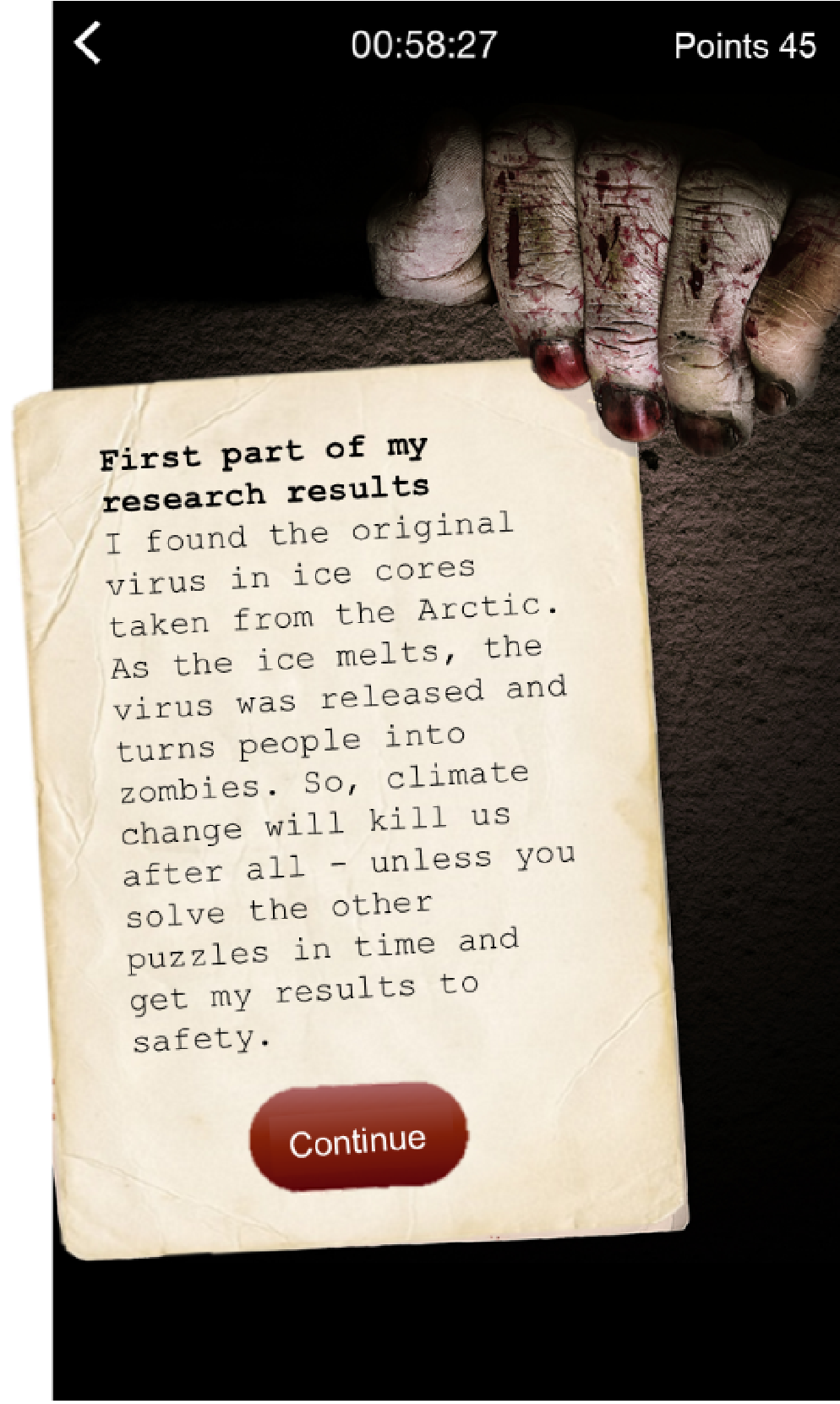
Among many environmental challenges, agriculture has a significant environmental impact in different ways (e.g. greenhouse gas emissions or land use) and it is important that we question and change our food consumption patterns [e.g. Ritchie, Rosado & Roser, 2022]. The topic of sustainable nutrition is addressed in the university gardens and was selected as the main topic for the puzzles. 4 out of 10 puzzles were directly dedicated to this topic.
By solving a puzzle, the players receive information that leads them to the next puzzle at a different location in the gardens. An example can be seen in Figure 3. This puzzle aims to raise a better understanding of how animal products require an exceptionally high amount of land. A European family of four uses approximately the area of a soccer field to grow its food each year, of which almost half is used to grow feed for livestock, that provides meat and milk [Peters, Wilkins & Fick, 2007]. For vegetables, fruit, potatoes and bread, the family needs only about one tenth of the area [Peters et al., 2007]. This information including concrete numbers can be found on a garden installation and is used to calculate the correct answer. Other puzzles also incorporate scientific information on land use [based on von Koerber, Kretschmer, Prinz & Dasch, 2009]. Additionally, other topics are covered, such as greenhouse gas emissions, when comparing meals containing meat or fish with vegetarian meals [based on Stucki, Jungbluth & Flury, 2012], the origins of various foods and other exhibitions within the gardens that are indirectly related to sustainable nutrition (e.g. soil organisms). If a correct solution cannot be found, players can ask for up to three hints, with the correct answer being the last hint. Each hint reduces the total amount of points. Additional points are subtracted, if the mission is not finished within 60 minutes. The players then still have 15 additional minutes before the game is automatically terminated.
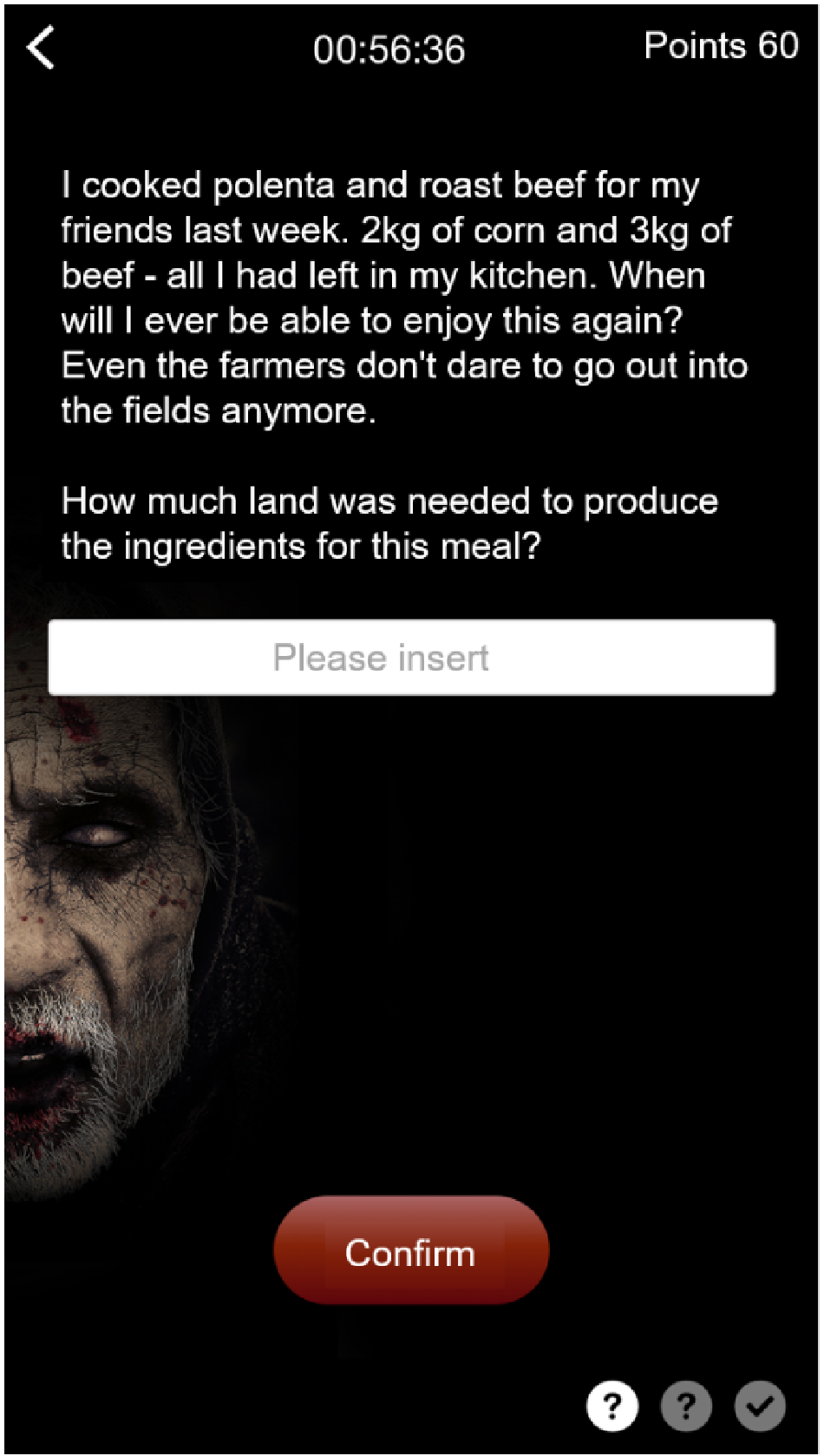
2.3 Research questions
To gain insights into how this scientainment approach can provide a new way to sensitize youth to sustainability and foster their interest in science, the Zombie mission was accompanied by a study. The following research questions (RQ) guided this study:
-
Which target groups can be reached by the Zombie mission?
-
Can the Zombie mission convey new facts about sustainability?
-
Does the Zombie mission motivate adolescents to revisit the university gardens or foster their interest in science and the environment, respectively? If so, what parts or topics specifically?
To answer these research questions, a mixed-method approach was applied.
2.4 Data collection
Secondary school classes (ages 12–18 years) were recruited to participate in this study. During the main data collection phase in September and October 2021, seven classes with a total of 170 students played the Zombie mission on site. In Switzerland, it is not necessary to obtain explicit consent from students or their caretakers to participate in a non-invasive scientific study during class. Having received a standardized instruction from research staff, including information about the scientific purpose of this study, the students were divided into groups of three or four, and played against each other. After finishing the game, the students completed a questionnaire. With some groups, group interviews were carried out instead.
In addition, date, username, puzzles solved, used hints, total amount of minutes played and the final score were collected from the app and analyzed.
2.5 Survey
An online questionnaire was designed to be completed in 10 minutes or less and had to be filled out by the participants after playing the mission.
After a few demographic inquiries, questions were asked about the mission in general, its attractiveness, the participant’s attitude towards science, environmental behavior and playing affinity. Open questions were added to cover new learnings and motivation to revisit the gardens. In addition, specific knowledge questions about sustainable nutrition conveyed in the Zombie mission (three items, multiple-choice, e.g. “Which requires more land: the production of 1 kg of chicken or the production of 1 kg of corn?”) as well as standardized general scientific knowledge questions (10 items, true/false, e.g. “The innermost part of the earth is very hot”) were asked.
The latter originated from the Euromonitor [Bauer, Shukla & Kakar, 2012] and were asked to evaluate the impact of general scientific knowledge on the learning effect. Those about environmental behavior were translated and adapted from the revised Environmental Perception scale by Johnson and Manoli [2008]. All other questions were specifically developed for this survey. The complete survey was pretested with a school class.
119 students filled out the questionnaire on their phones after playing the mission in the gardens. Once the data was cleaned, the evaluation could be carried out with 81 respondents.
2.6 Interviews
Due to the exploratory nature of the RQ, 16 semi-structured, qualitative group interviews were conducted after mission completion, with 45 participants. For example, during the survey, we inquired whether the participants enjoyed playing the mission. We further explored this topic during the interview by asking about their thoughts on the story involving the zombies. We also asked about the participant’s interest in the environment and their behavior and habits, for a better understanding of the target group (RQ 1).
In addition, as there were only three knowledge questions in the survey, the interviews enabled a better understanding of what the students had learnt in the mission (RQ 2). Lastly, the interviews were designed to give an insight into why the participants would revisit the university gardens (RQ 3).
The interviews were standardized, i.e. the instructions, the wording and the order of the questions were predefined (following the topics of the written questionnaire) and all interviews were carried out by instructed research staff. Interviews lasted approx. 10–15 minutes and were recorded in writing.
2.7 Control group
In June 2022, a comparative follow-up survey was carried out with a control group of 59 students from the corresponding secondary school levels. These students filled out the same survey as the participants of the main study without having played the mission.
2.8 Data analysis
Qualitative data from the interviews were analyzed with a thematically category system, using the MAXQDA2022 software.
The survey data were subsequently enriched with weather data (e.g. temperature and rain) and scores from the app. The data was then analyzed with IBM SPSS Statistics 28. Descriptive and few inferential statistical methods were applied.
3 Results
The participants of the main survey were between 12 and 18 years old. The average age was 15.4 years.
The mission was played by 51 groups; one of the groups is depicted in Figure 4. On average, the mission was completed within 50 minutes. Only 8% failed finishing the mission before the maximum amount of 75 minutes. 8.7 of 10 puzzles were solved correctly, on average, with a total of 6.5 hints needed.
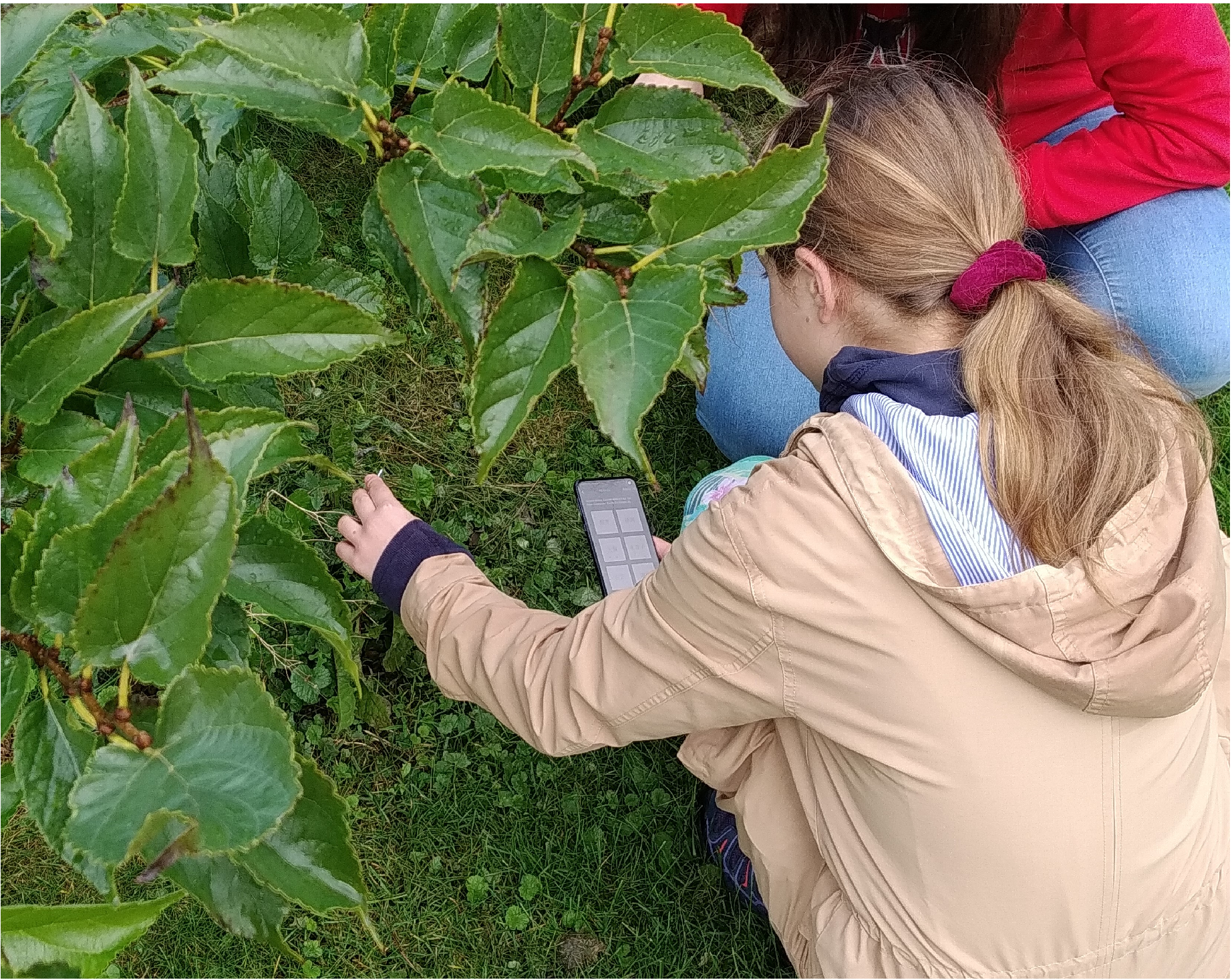
Table 1 shows the descriptive statistics on how the mission was assessed in general.
Exploratory factor analyses were conducted and new variables were formed for mission attractiveness, attitude towards science, environmental behavior and playing affinity. Kaiser-Meyer Olkin measure of sampling adequacy suggested that the samples were factorable.
As shown in Table 1, the students revealed on average a positive attitude towards science (, ). Most participants also consider themselves rather environmentally friendly (, ). Results for gaming affinity were more widely divergent between subjects. The mean value was 2.81, yet with a standard deviation of 1.05, indicating a few respondents with a very low and some with a high gaming affinity.
The results of the general scientific knowledge questions show that, of all participants (), 49% had very good scientific knowledge, 47% fairly good scientific knowledge and 4% were categorized in the group with fairly poor scientific knowledge. This distribution corresponds to the Swiss average [European Commission, 2021] and also to the participants’ attitude towards science.
3.1 Playing the Zombie mission is fun
Most of the participants found playing the Zombie mission was fun (, , ). All items regarding the attractiveness of the mission (see Table 1) were combined to form the mean index “mission attractiveness” (Cronbach’s ), resulting in a mean value of 3.35 (, ).
Responses from the interviews were in line with these findings. The students also expressed very positive opinions about the zombie story. Students of group 1 mentioned for example: “Exciting, thrilling, mega cool. It was easy to imagine and immerse yourself in it”. Most of the groups stated that “the story was fun and exciting” (e.g. group 14). Two groups also mentioned the AR feature in the interviews, e.g. “the shooter was good; more AR features would be cool” (group 9). However, there were a few groups to which the zombie story did not appeal. Students from group 13 mentioned, for example: “The story in itself is not so good. Sometimes it is not clear what this has to do with [the topic]”.
Apart from the story, the weather had an impact on how well the game was received. The descriptive analysis shows that the game was perceived as less fun on a rainy day (, ), compared to sunny weather (, ). The game was most fun when it was sunny and warm (, ). This was also confirmed in the interviews. Group 9 stated that “it was cold and the game would have been more fun in summer”.
As shown in Figure 5, the intention of the participants to recommend the mission to friends is evenly dispersed, resulting in a mean value of 2.99 (, ).
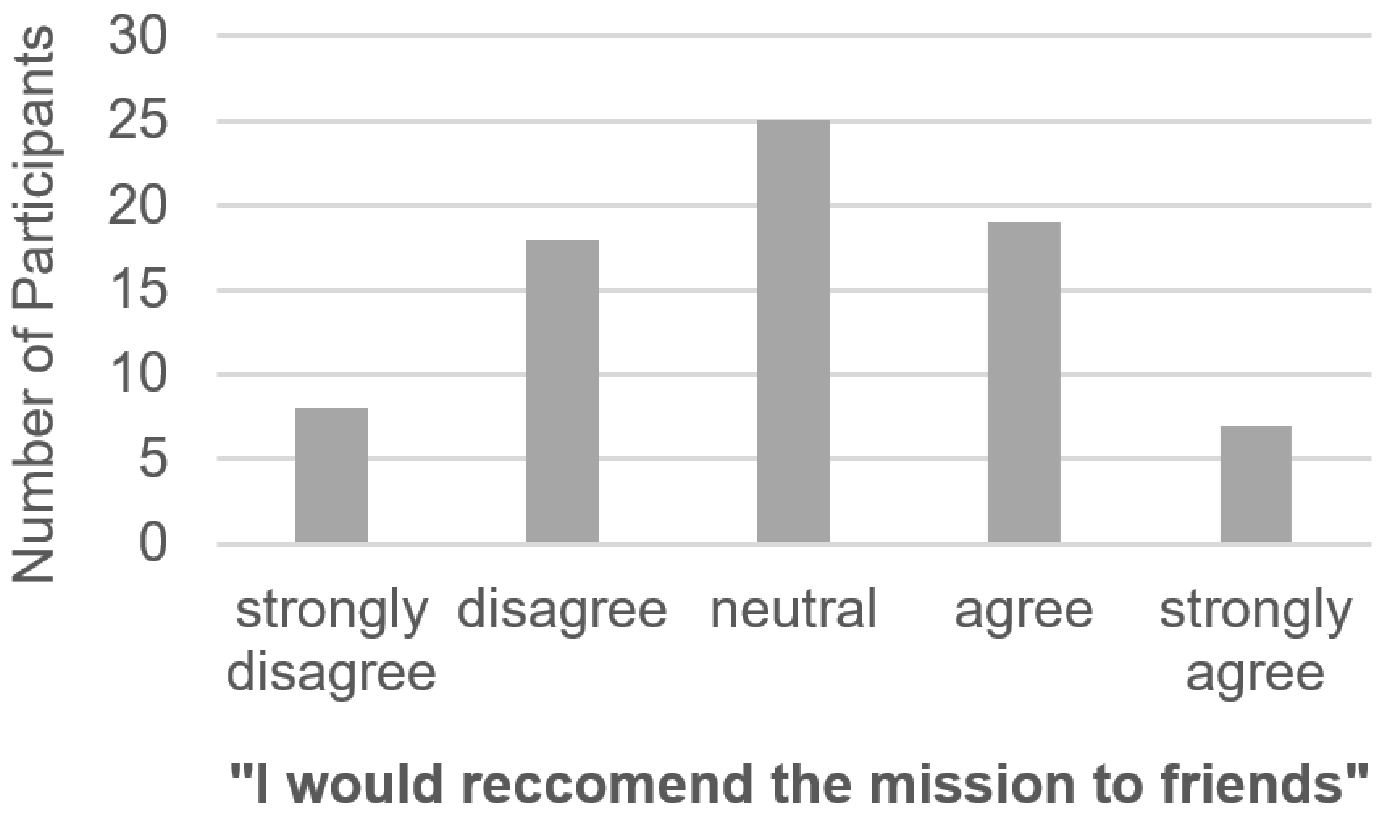
One third stated that they would recommend the mission to friends, one third would maybe recommend it, resulting in one third that would not recommend it. The main reasons for the latter were stated as that the game was too difficult (five times) or that the instructions were sometimes unclear (four times). This was also confirmed in the interviews by six groups, e.g. group 10: “It was sometimes unclear where you could find the info you needed at a particular location”.
3.2 A low interest in sustainability or in science does not affect how much participants enjoy playing the Zombie mission
Scatter plot analysis showed no correlation between mission attractiveness and attitude towards science or mission attractiveness and environmental behavior, respectively.
In addition, a Spearman’s rank correlation was computed. No significant correlation could be identified between mission attractiveness and attitude towards science (, , ), nor between mission attractiveness and environmental behavior (, , ). This was confirmed in the interviews. Students from group 12, for example, stated that the environment was not important to them and that they were “not the garden types”. However, they said “the idea was cool” and that the mission was fun to play.
3.3 By playing the Zombie mission participants learn new facts about sustainability
In the questionnaire, 42% of the participants self-reported that they learned something new during the mission. They were also asked to write what they have learned. Students stated that they have learned how much land is needed to grow food (seven mentions), environmental topics in general (three mentions) or that there is an increasing need for agricultural land in the future (three mentions).
The interviews revealed that many students already had some basic knowledge about sustainable nutrition, for example that meat is less sustainable than other foods. However, through the mission they could add to their knowledge. Group 14 stated for example: “I’ve heard of environmental impact points. Not, however, in relation to menus”. In the interviews, the participants could name 25 different learnings in total. The main topics were meat consumption, environmental impact, land use and origins of certain types of food. Group 4 added: “[The Zombie mission] is a great concept to learn new things!”
The results of the written knowledge test show that most of the questions about sustainable nutrition were answered correctly (see Figure 6a). From 81 students, a total of 29 respondents answered all three questions correctly (36%). As many were able to answer two questions correctly. 19 people answered one question correctly (23%) and four people were unable to give any correct answer (5%). No relationships could be identified between the level of the participant’s general scientific knowledge and the results of the knowledge test.
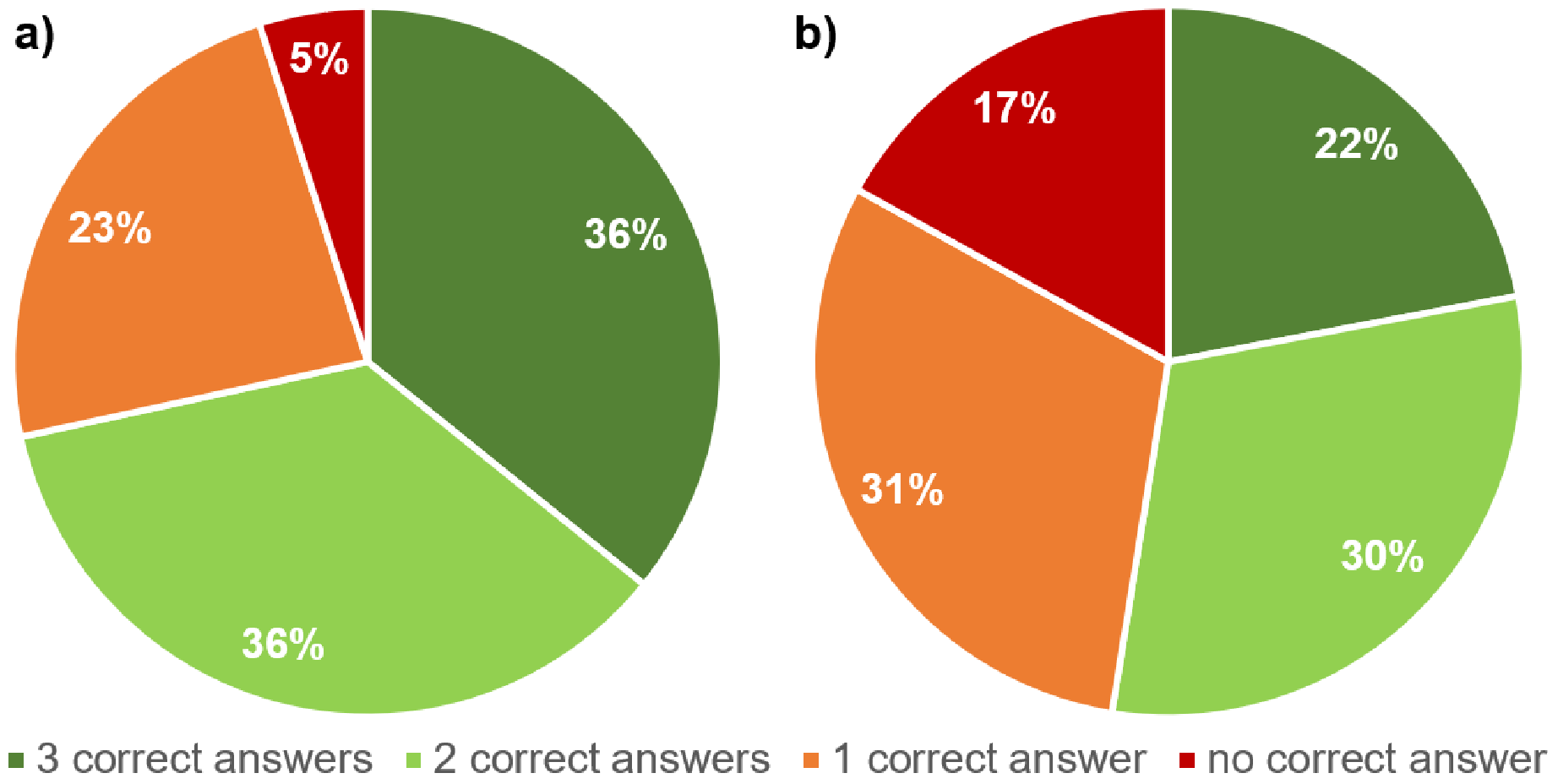
The results from the control group, as depicted in Figure 6b, showed that a total of 13 respondents answered all three questions correctly (22%). 18 respondents answered two questions correctly (31%), 18 were able to answer one question correctly (31%) and 10 participants were unable to give any correct answer (17%).
People in the main survey had more right answers on average. However, statistically, no significant effect was found (, ).
3.4 After playing the Zombie missions, some participants became interested in the university’s gardens and its scientific exhibitions
The interviews revealed that most students would in fact like to visit the gardens again in order to look at the plants but also at the different thematic areas or scientific exhibitions. For example, Group 4 mentioned: “I would like to take a closer look at the different exhibitions”. Two groups (10 and 11) stated that they would only like to come back in the context of a school excursion. Overall, most students would only come back in sunny weather.
The latter might be one of the reasons why — answered after playing the mission mostly in the cold — only 19% of the respondents () stated in the survey, that they would like to take a closer look at the gardens, specifically at the plants. However, consistent with the interviews, specific exhibitions or thematic areas were mentioned by seven persons as other reasons to visit again.
4 Discussion
Overall, the mission was perceived positively by the participants, as being fun and entertaining. Narratives have been shown to increase engagement when communicating science to non-expert audiences, however, one story is not going to work on everybody [Cormick, 2019]. This was confirmed with this project. While the zombie storyline did not appeal to all players, it was engaging and motivating for most of the participants. The players followed the stages of the story and solved the scientific puzzles along the way. A low interest in sustainability or in science did not affect how much participants enjoy playing the Zombie mission. Nor did the playing affinity or the general science knowledge of the participants. The target group of the Zombie mission thus includes a broad audience of young people from 12 years, including adolescents with no prior interest in sustainability or science (RQ 1).
Nevertheless, there is room for improvement. Negative feedback is mainly related to the weather or usability of the game (e.g. unclear instructions or tasks that are too difficult). To improve usability and mission attractiveness, future projects should implement user-centered design. This iterative process addresses the needs of the users as early as possible in the development process and includes thorough testing with prototypes of the game [Ng & Khong, 2014]. According to Ng and Khong [2014], user feedback is of utmost importance in gaining insights on how to help make the game more fun and inspiring to play.
From evaluating the self-reported learnings together with the knowledge test and comparing it to the results of the control group, it appears that the mission was successful in communicating scientific insights on sustainable nutrition (RQ 2). However, no significant learning effect was identified. As deliberately only few learning targets are taught within the framework of a scientainment project and as only few of the puzzles related to the topic of sustainable nutrition, little learning content could be queried. Furthermore, a pre-survey was not conducted as it would have included questions specifically related to sustainable nutrition, which could have biased the final survey results by drawing attention to this topic prior to the game. More puzzles on the same topic would better facilitate the evaluation of a learning effect and would allow a more comprehensive knowledge test. Additionally, open questions on acquired learnings in questionnaires (in addition to the knowledge quiz) are not advisable. The interview format is better suited for such explorative questions.
The same applies to the question of which parts of the gardens would motivate the students to revisit. The results of the interviews revealed that such a mission can be used to draw attention to the gardens and their scientific exhibitions and to motivate people to visit again (RQ 3). However, only about one fifth of the respondents in the written survey expressed a raised interest towards the university’s surroundings. On the one hand, this was probably partly due to the often cold weather and the open question in the questionnaire (“yes, that’s why:”), which were not very popular among the participants. On the other hand, it might also show that many of the young people were not interested in gardens and science exhibitions, but still played through the game and had fun doing so. Further studies would be necessary to find out whether the mission generally increased interest in the scientific topics and led to behavioral change in the longer term.
Unfortunately, of the 119 participants of the survey, only 81 questionnaires could be analyzed. Statistical analyses were thus limited. However, the present results look promising. For future projects, further quantitative evaluations could be made with a larger sample.
No statements can be made as to whether such a mission, the resulting positive emotions and the immersion in the Zombie story, can be used to communicate content better than more traditional communication tools. While there are many studies that did find that serious games can contribute effectively to knowledge enhancement [e.g. Mortara et al., 2014], there are studies which could not identify a significant learning effect when comparing a virtual serious game with traditional learning methods [Wrzesien & Alcañiz Raya, 2010]. However, Wrzesien and Alcañiz Raya [2010] did find their students to be more engaged. This is consistent with the results of this project.
5 Conclusion
Engaged by an entertaining narrative, the Zombie mission allows adolescents to spend time in nature while absorbing scientific information on a globally important topic.
As information on sustainability often only reaches persons with an existing concern for the environment, playful scientainment approaches such as the Zombie mission are promising tools to disseminate information on environmental issues and to sensitize a young target group — especially those with no prior interest in the environment or science.
In a follow-up project, the learnings have been applied in a similar mission about biodiversity for children. More immersive with many Augmented Reality features, it appeals to an even younger target group. A comprehensive evaluation, that considers the above-mentioned limitations, will contribute to the question how science communication through scientainment can engage people effectively.
References
-
Bättig-Frey, P., Jäger, M. U. & Treichler Bratschi, R. (2018). Combining art with science to go beyond scientific facts in a narrative environment. Journal of Museum Education 43 (4), 316–324. doi:10.1080/10598650.2018.1523624
-
Bauer, M. W., Shukla, R. & Kakar, P. (2012). Public understanding of science in Europe 1989–2005. A Eurobarometer trend file. doi:10.4232/1.11382
-
Cai, H. (2013). Using augmented reality games as motivators for youth environmental education: an American Hart’s tongue fern conservation project (MSc thesis, State University of New York).
-
Cormick, C. (2019). Who doesn’t love a good story? — What neuroscience tells about how we respond to narratives. JCOM 18 (05), Y01. doi:10.22323/2.18050401
-
European Commission (2021). Special Eurobarometer 516: European citizens’ knowledge and attitudes towards science and technology [Country Factsheet Switzerland]. Retrieved from https://europa.eu/eurobarometer/surveys/detail/2237
-
Gebert Rüf Stiftung (n.d.). Scientainment. Retrieved June 16, 2022, from https://www.grstiftung.ch/en/area-activity/scientainment.html
-
Jaisli, I., Bättig-Frey, P., Eymann, L., Mariani, E. & Stucki, M. (2019). Scientainment for sustainability: the eco-confessional as a new approach for life cycle thinking. Sustainability 11 (20), 5686. doi:10.3390/su11205686
-
Jensen, E. A. & Gerber, A. (2020). Evidence-based science communication. Frontiers in Communication 4, 78. doi:10.3389/fcomm.2019.00078
-
Johnson, B. & Manoli, C. C. (2008). Using Bogner and Wiseman’s Model of Ecological Values to measure the impact of an earth education programme on children’s environmental perceptions. Environmental Education Research 14 (2), 115–127. doi:10.1080/13504620801951673
-
Katsaliaki, K. & Mustafee, N. (2015). Edutainment for sustainable development: a survey of games in the field. Simulation & Gaming 46 (6), 647–672. doi:10.1177/1046878114552166
-
Lee, K. (2011). The role of media exposure, social exposure and biospheric value orientation in the environmental attitude-intention-behavior model in adolescents. Journal of Environmental Psychology 31 (4), 301–308. doi:10.1016/j.jenvp.2011.08.004
-
Michelsen, G. & Godemann, J. (Eds.) (2005). Handbuch Nachhaltigkeitskommunikation: Grundlagen und Praxis [Manual of sustainability communication: foundations and practice]. Munich, Germany: Oekom Verlag.
-
Mortara, M., Catalano, C. E., Bellotti, F., Fiucci, G., Houry-Panchetti, M. & Petridis, P. (2014). Learning cultural heritage by serious games. Journal of Cultural Heritage 15 (3), 318–325. doi:10.1016/j.culher.2013.04.004
-
Murmann, M. & Avraamidou, L. (2014). Narrative as a learning tool in science centers: potentials, possibilities and merits. JCOM 13 (02), A02. doi:10.22323/2.13020202
-
Ng, Y. Y. & Khong, C. W. (2014). A review of affective user-centered design for video games. In 2014 3rd International Conference on User Science and Engineering (i-USEr) (pp. 79–84). doi:10.1109/IUSER.2014.7002681
-
Peters, C. J., Wilkins, J. L. & Fick, G. W. (2007). Testing a complete-diet model for estimating the land resource requirements of food consumption and agricultural carrying capacity: the New York State example. Renewable Agriculture and Food Systems 22 (2), 145–153. doi:10.1017/s1742170507001767
-
Ritchie, H., Rosado, P. & Roser, M. (2022). Environmental impacts of food production. Our World in Data. Retrieved from https://ourworldindata.org/environmental-impacts-of-food
-
Sanchez, E. & Plumettaz-Sieber, M. (2019). Teaching and learning with escape games from debriefing to institutionalization of knowledge. In M. Gentile, M. Allegra & H. Söbke (Eds.), Games and Learning Alliance: 7th International Conference, GALA 2018. Palermo, Italy, December 5–7, 2018. Proceedings (pp. 242–253). doi:10.1007/978-3-030-11548-7_23
-
Stucki, M., Jungbluth, N. & Flury, K. (2012). Ökobilanz von Mahlzeiten: Fleisch- & Fischmenüs versus vegetarische Menüs [Poster]. Wädenswil, Switzerland.
-
Swiss Academies of Arts and Sciences (2021). Science in the Swiss public. The state of science communication and public engagement with science in Switzerland. Swiss Academies Reports 16 (8). doi:10.5281/zenodo.4974312
-
von Koerber, K., Kretschmer, J., Prinz, S. & Dasch, E. (2009). Globale Nahrungssicherung für eine wachsende Weltbevölkerung — Flächenbedarf und Klimarelevanz sich wandelnder Ernährungsgewohnheiten. Journal für Verbraucherschutz und Lebensmittelsicherheit 4 (2), 174–189. doi:10.1007/s00003-009-0486-1
-
Wrzesien, M. & Alcañiz Raya, M. (2010). Learning in serious virtual worlds: evaluation of learning effectiveness and appeal to students in the E-Junior project. Computers & Education 55 (1), 178–187. doi:10.1016/j.compedu.2010.01.003
Authors
Petra Bättig-Frey is a biologist with experience in the communication of complex content.
After her doctoral thesis in plant biotechnology at the ETH Zurich, she gained her first
experience in science communication at UC Berkeley in California. She then worked as a
science communication project leader gaining experience organizing public events,
exhibition projects or social media content. Since August 2013, she is a lecturer at the
Institute of Natural Resource Sciences, developing, researching, and teaching innovative
methods for sustainability communication.
@petrabaettig E-mail: bape@zhaw.ch
Mirjam West, BSc in Energy and Environmental Engineering and currently completing
an MSc in Environment and Natural Resources, is a research associate at the ZHAW
Institute of Natural Resource Sciences. There, she is involved in various sustainability
communication and evaluation projects. She has previously worked for 4 years at the
Institute for Sustainable Development, where she led Virtual & Augmented Reality
projects making complex sustainability topics tangible.
E-mail: xwsj@zhaw.ch
Rahel Skelton has experience in communicating science around sustainability in
everyday and unexpected places, combining facts with design, storytelling, and
technology. She holds a Master’s degree in Sustainable Development and has experiences
in tour guiding museums and exhibitions on sustainability, geography and agriculture.
Since 2015, she works as a research associate at the Institute of Natural Resource
Sciences, creating, managing, and evaluating science communication initiatives and
technology-enabled forms of engagement, and teaching courses on communicating
science innovatively.
E-mail: rahel.skelton@zhaw.ch
Verena Berger has a Master’s degree in marketing and is currently working on her
doctoral thesis. She worked as a research associate at the Institute of Natural
Resource Sciences at the Zurich University of Applied Sciences in Wädenswil,
Switzerland for 15 years. There she carried out research in the fields of sustainability
communication and behavioral change to deliver effective measures that can be
taken to motivate various target groups to consume sustainably. She is passionate
about linking issues such as sustainability, behavior change, and digitalization
and the consequential opportunities to help combat the progression of climate
change.
E-mail: verena_berger@hispeed.ch
